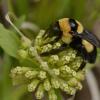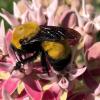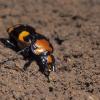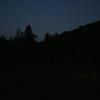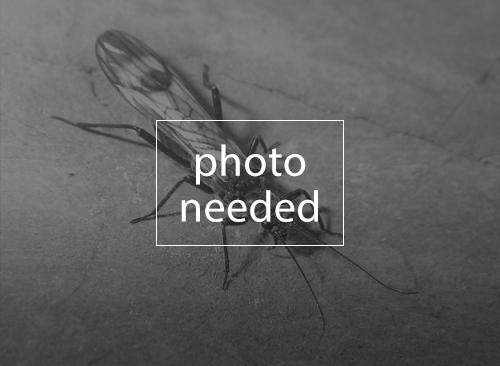
(Gastropoda: Cerithioidea: Pleuroceridae)
Juga is a genus of medium-sized, aquatic snails. Juga silicula is confined to a few streams in the Nisqually and Big Soos Creek drainages on the southeastern end of the Puget Sound, Washington. This benthic species occurs in small freshwater streams flowing into the Puget Sound (Strong and Frest, 2007). The egg masses of Juga are most often found in loose (non-cemented) but stable cobble substrate, with free and fairly vigorous flow through at least the upper substrate layers (Frest and Johannes 2006). Juga snails are characterized as rasper-grazers, feeding on both algae and detritus, such as dead alder leaves (Furnish 1989, Allan 1995). Major threats to these species include rapidly increasing housing and commercial development. Conservation measures include managing new and known sites and their associated watersheds and conducting additional population surveys.
Juga silicula is the type species for the Juga genus, which is currently divided into two extant subgenera, Calibasis and Juga (Strong and Frest 2007). Juga silicula belongs to the Juga subgenus, which is characterized by the strong and consistently arranged plicae on the immediate post nepionic whorls (Frest and Johannes 2006).
Based on anatomical and molecular data, this species is valid, but its range is much more restricted than was previously believed (Strong and Frest 2007). DNA phylogeny of described and undescribed Upper Sac-Pit Juga recognizes about 17 to 21 named valid forms and about 10 to15 new taxa (NatureServe 2009). Minimally, Juga silicula, Juga nigrina, Juga occata, Juga hemphilli, and Juga acutifilosa are likely composite taxa, and many populations formerly ascribed to Juga silicula actually belong to a number of undescribed Juga species (Strong and Frest 2007, Frest 2007, pers. comm. in NatureServe 2009, Johannes 2009, pers. comm.). Anything called J. silicula outside of the Puget Sound region should be considered another Juga species until proven otherwise (Johannes 2009, pers. comm.).
Juga is a genus of medium-sized, aquatic snails in the family Pleuroceridae, commonly known as river snails. This family differs from the Hydrobiidae in that the males lack a verge (male copulatory organ). The genus Juga is distinct from other pleurocerid snails based on reproductive anatomy and egg mass characters (Taylor 1966), as well as features of the ovipositor pore, radula, midgut, kidney, and pallial gonoduct (Strong and Frest 2007). Members of this genus have a tall, conic shell-shape and thick, heavy shells which are commonly decollate (early whorls lost). The operculum is present and they are gill breathing and dioecious (separate sexes).
The external anatomy of Juga silicula is described as follows (Strong and Frest 2007): Operculum ovate, corneous, dark reddish brown in color, with 3.5 whorls; paucispiral with eccentric nucleus of approximately 3 whorls. Nucleus comprising slightly less than one half of total length (<45%). Head-foot dark gray to black in color, with lighter gray snout tip and pale foot sole; in females, ovipositor groove pale in color. Foot broad with wide propodium and long anterior pedal gland along anterior margin. Ciliated egg groove forming longitudinally grooved tract extending from anterior tip of pallial gonoduct and broadening continuously into shallow triangular shelf on side of neck below right cephalic tentacle. Ovipositor surface grooved, with folds directed medially into pore. Shallow grooved tract extending from pocket to edge of foot, a short distance back from anterior pedal gland. Extensible snout broad, squarish, with short triangular cephalic tentacles; tentacles also short in relaxed specimens. Ctenidium extending from posterior end of mantle cavity to near mantle edge, anteriorly curving toward the left. Osphradium forming simple ridge alongside efferent branchial vessel, sometimes with anterior tip markedly curving toward the left; osphradium undulating slightly at anterior and posterior ends, thinning posteriorly. Hypobranchial gland moderately well developed with transverse ridges, especially at posterior end of mantle cavity (Strong and Frest 2007).
Juga snails are characterized as rasper-grazers, feeding on both algae and detritus, such as dead alder leaves (Furnish 1989, Allan 1995). Individuals in the Juga genus may live for 5-7 years, reaching sexual maturity in 3 years and continuing to grow (Furnish 1990). Adults in this genus are gonochoristic (as opposed to hermaphroditic). Reproduction is iteroparous (individuals are capable of having offspring many times), and most Juga species appear to breed and lay eggs once a year as adults (Frest and Johannes 2006). The same egg-laying localities are utilized year after year if undisturbed. There is no veliger stage, and juvenile snails emerge from eggs (Frest and Johannes 2006).
This species is confined to a few streams in the Nisqually and Big Soos Creek drainages on the southeastern end of the Puget Sound, Washington. Many populations formerly ascribed to this species actually belong to a number of as yet undescribed Juga species (Johannes 2009, pers. comm., Strong and Frest 2007). Although the type locality is indicated as “Nisqually, Oregon”, the type would have been collected in 1838-1842, before the separation of Washington Territory from the larger Oregon Territory in 1853, and hence the collection occurred in what is now Washington State (Strong and Frest 2007). The “Nisqually” locality likely referred to Fort Nisqually on the Nisqually Reach directly south of Sequalitchew Creek – a Puget Sound tributary northeast of the Nisqually River (Strong and Frest 2007). Since the Nisqually River is a glacial flour stream with depauperate freshwater mollusk fauna, the type specimens are likely from Sequalitchew Creek or one of the other nearby tributaries of the Nisqually River in Pierce County (Strong and Frest 2007). There is also a historic record from Murry Creek, Pierce County, Washington (Deixis MolluscDB 2009). Attempts to collect Juga from the boggy Sequalitchew Creek have been unsuccessful (Frest unpublished data, in Strong and Frest 2007). The species is currently known from McAllister Creek in Thurston County, and Ravensdale Creek, Jenkins Creek, and Little Soos Creek in King County (Deixis MolluscDB 2009, Strong and Frest 2007). Deixis collection sites in Astoria, Oregon, Mason County, Washington (Mill Creek), and Lewis County, Washington (Skookumchuck River) are now considered to have an undescribed species of Juga (Johannes 2009, pers. comm.).
Global Status (2007): G2
National Status (United States): N2
State Status: Washington: SNR
(NatureServe 2009).
All of the creeks where this species occurs are threatened by rapidly increasing housing and commercial development (Johannes 2009, pers. comm.). The source for Little Soos Creek (Lake Young) is used as a water supply reservoir (Lake Young Watershed) connected to the City of Seattle Cedar River aqueduct. Upper Jenkins Creek (just below its source at Lake Wilderness) has been recently daylighted through a golf course. The mid part of Jenkins Creek is in City of Kent Watershed, where water is presumably diverted (Johannes 2009, pers. comm.). Additional City of Kent Watersheds occur on other tributaries in the range of this species, such as Cranmar Creek (Johannes 2009, pers. comm.). Many streams within the Big Soos Creek watershed fail to meet Washington State water quality standards, having unhealthy temperature and oxygen conditions, altered water depth and flow, increased erosion and sediment loss, lack of streamside vegetation (shade), and increased nutrient loading (Lee 2009). The “Focus on Soos Creek Watershed” report provides an overview of the sources of these problems, including water withdrawals for irrigation and drinking, stormwater run-off from impervious surfaces, and poorly managed forestlands, agricultural areas and construction sites (Lee 2009).
Inventory: Recent anatomical and genetic analyses have so far revealed that J. silicula is limited to the Nisqually and Big Soos Creek drainages in Washington (Johannes 2009, pers. comm.). Additional surveys of Puget Sound tributaries on the southeastern end of the Puget Sound are needed to accurately delineate the geographic range of this species. In particular, the area between the Big Soos and Nisqually drainages should be investigated for the presence of this species, as well as the drainages just south of the Nisqually River, such as the Deschutes, Black, and Chehalis Rivers (Johannes 2009, pers. comm.). As of yet, surveys by Ed Johannes of creeks south of Big Soos Creek drainage have not found any Juga (Johannes 2009, pers. comm.). Standardized abundance estimates for this species at new and known sites would assist future conservation efforts, since population size is important in evaluating the stability of a species at a given locality.
Management: Manage new and known sites and their associated watersheds to reduce the impacts of urban development, water diversions, construction activities, and other practices that may adversely affect water quality. Riparian habitat protection, including maintenance of water quality, substrate conditions, and canopy cover, would likely benefit and help maintain this species.
Allan, J. David. 1995. Stream ecology: structure and function of running waters. Chapman & Hall, New York, NY. 388 pp.
Deixis MolluscDB database. 2009. An unpublished collection of mollusk records maintained by Ed Johannes.
Frest, T.J. and E.J. Johannes. 2006. Draft. Review of the Status of Juga (Western U. S. Cerithioidea, Pleuroceridae, Semisulcospirinae). Unpublished document available from Ed Johannes.
Furnish, J.L., 1989, Factors Affecting the Growth Production and Distribution of the Stream Snail Juga silicula (Gould) [Doctoral Dissertation]: Department of Entomology, Oregon State University, 216 p.
Furnish, J.L. 1990. Factors affecting the growth, production and distribution of the stream snail Juga silicula (Gould). Unpublished PhD thesis, Oregon State University, 173 pp.
Johannes, Ed. 2009. Personal communication with Sarah Foltz Jordan.
Lee, S. 2009. Focus on Soos Creek Watershed. Department of Ecology, State of Washington. Available at http://www.ecy.wa.gov/biblio/0910003.html (Last accessed 18 Nov 2009).
NatureServe. 2009. “Juga silicula.” NatureServe Explorer: An online encyclopedia of life [web application]. Feb. 2009. Version 7.1. NatureServe, Arlington, Virginia. http://www.natureserve.org/explorer/ (last accessed 27 Sep. 2009).
Strong, E.E. and T.J. Frest. 2007. On the anatomy and systematics of Juga from western North America(Gastropoda: Cerithioidea: Pleuroceridae). The Nautilus 121(2): 43-65.
Taylor, D.W. 1966. Summary of North American Blancan Nonmarine Mollusks. Malacologia 4:1-172.
Sarah Foltz Jordan and Julia Janicki, The Xerces Society for Invertebrate Conservation.

